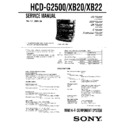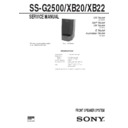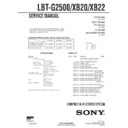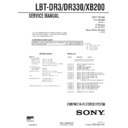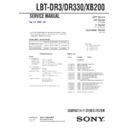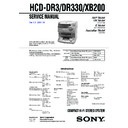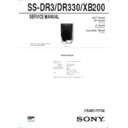Sony HCD-G2500 / HCD-XB20 / HCD-XB22 / LBT-G2500 / LBT-XB20 / LBT-XB22 Service Manual ▷ View online
— 2 —
Tuner section
FM stereo, FM/AM superheterodyne tuner
FM tuner section
Tuning range
87.5 – 108.0 MHz
Antenna
FM lead antenna
Antenna terminals
75
Ω
unbalanced
Intermediate frequency
10.7 MHz
AM tuner section
Tuning range
(2 band model)
(2 band model)
North American model:
530 – 1,710 kHz
(with the tuning interval set at 10 kHz)
(with the tuning interval set at 10 kHz)
Other models:
531 – 1,602 kHz
(with the tuning interval set at 9 kHz)
530 – 1,710 kHz
(with the tuning interval set at 10 kHz)
(with the tuning interval set at 9 kHz)
530 – 1,710 kHz
(with the tuning interval set at 10 kHz)
(3 band model)
MW:
531 – 1,602 kHz
(with the tuning interval set at 9 kHz)
(with the tuning interval set at 9 kHz)
LW:
153 – 279 kHz
(with the tuning interval set at 3 kHz)
(with the tuning interval set at 3 kHz)
Antenna
AM loop antenna
Antenna terminals
External antenna terminal
Intermediate frequency
450 kHz
General
Power requirements
North American model:
120 V AC, 60 Hz
Mexican model:
120 V AC, 50/60 Hz
European model:
230 V AC, 50/60 Hz
Australian, South African and Thailand models:
220 – 240 V AC, 50/60 Hz
Other models:
110 – 120 V AC or 220 – 240 V AC,
50/60 Hz (adjustable with voltage selector)
50/60 Hz (adjustable with voltage selector)
Power consumption
130 W
Dimensions (w/h/d) incl. projecting parts and controls
Approx.355
×
423
×
440 mm
(14
×
16
3
/
4
×
17
3
/
8
in)
Mass
Approx. 14.0 kg (30 lb 14 oz.)
Supplied accessories
AM loop antenna (1)
Remote RM-SG5 (1)
FM lead antenna (1)
Remote RM-SG5 (1)
FM lead antenna (1)
Design and specifications are subject to change without notice.
CAUTION
Use of controls or adjustments or performance of procedures
other than those specified herein may result in hazardous
radiation exposure.
other than those specified herein may result in hazardous
radiation exposure.
Notes on chip component replacement
• Never reuse a disconnected chip component.
• Notice that the minus side of a tantalum capacitor may be
• Notice that the minus side of a tantalum capacitor may be
damaged by heat.
Flexible Circuit Board Repairing
• Keep the temperature of soldering iron around 270˚C
during repairing.
• Do not touch the soldering iron on the same conductor of the
circuit board (within 3 times).
• Be careful not to apply force on the conductor when soldering
or unsoldering.
Laser component in this product is capable of emitting radiation
exceeding the limit for Class 1.
exceeding the limit for Class 1.
This appliance is classified as
a CLASS 1 LASER product.
The CLASS 1 LASER
PRODUCT MARKING is
located on the rear exterior.
a CLASS 1 LASER product.
The CLASS 1 LASER
PRODUCT MARKING is
located on the rear exterior.
This caution
label is located
inside the unit.
label is located
inside the unit.
SERVICING NOTE
NOTES ON HANDLING THE OPTICAL PICK-UP BLOCK
OR BASE UNIT
OR BASE UNIT
The laser diode in the optical pick-up block may suffer electrostatic
break-down because of the potential difference generated by the
charged electrostatic load, etc. on clothing and the human body.
During repair, pay attention to electrostatic break-down and also
use the procedure in the printed matter which is included in the
repair parts.
The flexible board is easily damaged and should be handled with
care.
break-down because of the potential difference generated by the
charged electrostatic load, etc. on clothing and the human body.
During repair, pay attention to electrostatic break-down and also
use the procedure in the printed matter which is included in the
repair parts.
The flexible board is easily damaged and should be handled with
care.
NOTES ON LASER DIODE EMISSION CHECK
The laser beam on this model is concentrated so as to be focused on
the disc reflective surface by the objective lens in the optical pick-
up block. Therefore, when checking the laser diode emission,
observe from more than 30 cm away from the objective lens.
the disc reflective surface by the objective lens in the optical pick-
up block. Therefore, when checking the laser diode emission,
observe from more than 30 cm away from the objective lens.
SAFETY-RELATED COMPONENT WARNING!!
COMPONENTS IDENTIFIED BY MARK
!
OR DOTTED LINE WITH
MARK
!
ON THE SCHEMATIC DIAGRAMS AND IN THE PARTS
LIST ARE CRITICAL TO SAFE OPERATION. REPLACE THESE
COMPONENTS WITH SONY PARTS WHOSE PART NUMBERS
APPEAR AS SHOWN IN THIS MANUAL OR IN SUPPLEMENTS
PUBLISHED BY SONY.
COMPONENTS WITH SONY PARTS WHOSE PART NUMBERS
APPEAR AS SHOWN IN THIS MANUAL OR IN SUPPLEMENTS
PUBLISHED BY SONY.
— 3 —
SAFETY CHECK-OUT
After correcting the original service problem, perform the following
safety checks before releasing the set to the customer:
Check the antenna terminals, metal trim, “metallized” knobs, screws,
and all other exposed metal parts for AC leakage. Check leakage as
described below.
safety checks before releasing the set to the customer:
Check the antenna terminals, metal trim, “metallized” knobs, screws,
and all other exposed metal parts for AC leakage. Check leakage as
described below.
LEAKAGE
The AC leakage from any exposed metal part to earth Ground and
from all exposed metal parts to any exposed metal part having a
return to chassis, must not exceed 0.5 mA (500 microampers).
Leakage current can be measured by any one of three methods.
1.
from all exposed metal parts to any exposed metal part having a
return to chassis, must not exceed 0.5 mA (500 microampers).
Leakage current can be measured by any one of three methods.
1.
A commercial leakage tester, such as the Simpson 229 or RCA
WT-540A. Follow the manufacturers’ instructions to use these
instruments.
WT-540A. Follow the manufacturers’ instructions to use these
instruments.
2.
A battery-operated AC milliammeter. The Data Precision 245
digital multimeter is suitable for this job.
digital multimeter is suitable for this job.
3.
Measuring the voltage drop across a resistor by means of a
VOM or battery-operated AC voltmeter. The “limit” indication
is 0.75 V, so analog meters must have an accurate low-voltage
scale. The Simpson 250 and Sanwa SH-63Trd are examples of
a passive VOM that is suitable. Nearly all battery operated
digital multimeters that have a 2V AC range are suitable. (See
Fig. A)
VOM or battery-operated AC voltmeter. The “limit” indication
is 0.75 V, so analog meters must have an accurate low-voltage
scale. The Simpson 250 and Sanwa SH-63Trd are examples of
a passive VOM that is suitable. Nearly all battery operated
digital multimeters that have a 2V AC range are suitable. (See
Fig. A)
To Exposed Metal
Parts on Set
0.15
µ
F
1.5 k
Ω
AC
Voltmeter
(0.75 V)
Voltmeter
(0.75 V)
Earth Ground
Fig. A. Using an AC voltmeter to check AC leakage.
TABLE OF CONTENTS
1. GENERAL
········································································· 4
—FRONT PANEL— ························································· 4
—BACK PANEL— ···························································· 5
—BACK PANEL— ···························································· 5
2. DISASSEMBLY
2-1.
Top Cover ··········································································· 6
2-2.
Front Panel Assy ································································· 6
2-3.
Main Board ········································································· 7
2-4.
Main Section ······································································· 7
2-5.
CD Mechanism Deck Section ············································ 8
2-6.
Tape Mechanism Deck ······················································· 8
2-7.
Cassette Door ····································································· 9
2-8.
CD Door Assy ···································································· 9
2-9.
Base Unit ·········································································· 10
2-10. Disc Table ········································································· 10
3. MECHANICAL ADJUSTMENTS
····························· 11
4. ELECTRICAL ADJUSTMENTS
······························· 11
5. DIAGRAMS
5-1.
Circuit Boards Location ··················································· 16
5-2.
Block Diagram —Deck Section— ··································· 17
5-3.
Block Diagram —Tuner/CD Section— ··························· 19
5-4.
Schematic Diagram —Main Section (1/2)— ··················· 21
5-5.
Schematic Diagram —Main Section (2/2)—
(US, AUS, MX model) ····················································· 25
(US, AUS, MX model) ····················································· 25
5-6.
Printed Wiring Board —Main Section—
(US, AUS, MX model) ····················································· 29
(US, AUS, MX model) ····················································· 29
5-7.
Printed Wiring Board —Main Section—
(AEP, UK, E, SP, MY, AR model) ···································· 34
(AEP, UK, E, SP, MY, AR model) ···································· 34
5-8.
Schematic Diagram —Main Section (2/2)—
(AEP, UK, E, SP, MY, AR model) ···································· 39
(AEP, UK, E, SP, MY, AR model) ···································· 39
5-9.
Schematic Diagram —Display Section— ························ 43
5-10. Printed Wiring Board —Display Section— ····················· 47
5-11. Printed Wiring Board —CD Section— ···························· 52
5-12. Schematic Diagram —CD Section— ······························· 57
5-13. Schematic Diagram —Power Section— ·························· 60
5-14. Printed Wiring Board —Power Section— ······················· 63
5-15. IC Block Diagrams ··························································· 68
5-16. IC Pin Function Description ············································· 71
5-11. Printed Wiring Board —CD Section— ···························· 52
5-12. Schematic Diagram —CD Section— ······························· 57
5-13. Schematic Diagram —Power Section— ·························· 60
5-14. Printed Wiring Board —Power Section— ······················· 63
5-15. IC Block Diagrams ··························································· 68
5-16. IC Pin Function Description ············································· 71
6. EXPLODED VIEWS
6-1.
Top Cover Section ···························································· 73
6-2.
CD Door Section ······························································ 74
6-3.
Panel Section ···································································· 75
6-4.
Main Section ····································································· 76
6-5.
Cassette Button Section ···················································· 77
6-6.
Cassette Mechanism Deck Section ··································· 78
6-7.
CD Mechanism Deck Section ·········································· 79
6-8.
Base Unit Section ····························································· 80
7. ELECTRICAL PARTS LIST
······································ 81
— 4 —
SECTION 1
GENERAL
1
I/
u
(POWER) button
2
DISPLAY/DEMO button
3
SPECTRUM ANALYZER button
4
ENTER/NEXT button
5
TUNER MEMORY button
6
TUNING MODE button
7
TUNER/BAND button
8
TUNING – button
9
TUNING + button
0
STEREO/MONO button
!¡
TAPE button
!™
CD button
!£
PHONO button
!¢
DBFB button
!∞
VOLUME knob
!§
DOLBY NR button
!¶
SURROUND button
!•
·
button
!ª
0
button
@º
)
button
@¡
6p
button
@™
P
button
@£
6
button
@¢
·
button
@∞
DISC SKIP button
@§
P
button
@¶
p
button
@•
)
button
@ª
≠
AMS
±
button
#º
0
button
#¡
DISC1 button
#™
DISC2 button
#£
DISC3 button
#¢
DISC4 button
#∞
DISC5 button
#§
r
button
#¶
·
button
#•
0
button
#ª
)
button
$º
6p
button
$¡
P
button
$™
PHONES jack
$£
ROCK button
$¢
POP button
$∞
JAZZ button
$§
SALSA button
$¶
FLAT button
$•
SLEEP button
$ª
t
/CLOCK SET button
%º
DAILY1 button
%¡
PLAY MODE button
%™
REPEAT button
%£
EDIT button
%¢
1/ALL DISC button
1
2
3
4
6
7
8 9
5
!º
!™
!¡
!∞
!•
!£
!¢
@¡
@™
@£
#¡
#™
#£
#¢
%¢
%¡
%™
%£
#∞
#§
#•
#¶
#ª
A
A
!ª
@º
@¢
@∞
!§
$™
!¶
@•
@§
@¶
@ª
#º
see
$§
$£
$¢
$º
$¶
$∞
$¡
$ª
$•
%º
– FRONT PANEL –

